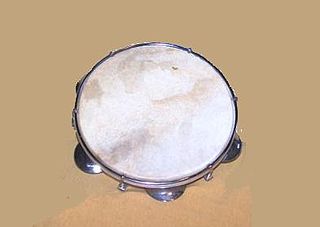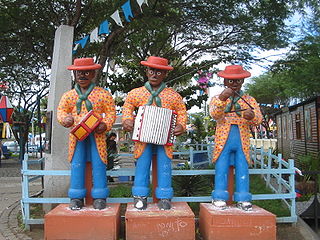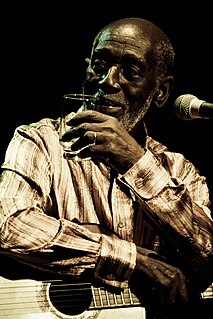
Samba, also known as samba urbano carioca or simply samba carioca, is a Brazilian music genre that originated in the Afro-Brazilian communities of Rio de Janeiro in the early 20th century. Having its roots in Brazilian folk traditions, especially those linked to the primitive rural samba of the colonial and imperial periods, it is considered one of the most important cultural phenomena in Brazil and one of the country's symbols. Present in the Portuguese language at least since the 19th century, the word "samba" was originally used to designate a "popular dance". Over time, its meaning has been extended to a "batuque-like circle dance", a dance style, and also to a "music genre". This process of establishing itself as a musical genre began in the 1910s and it had its inaugural landmark in the song "Pelo Telefone", launched in 1917. Despite being identified by its creators, the public, and the Brazilian music industry as "samba", this pioneering style was much more connected from the rhythmic and instrumental point of view to maxixe than to samba itself.

Samba is a lively dance of Afro-Brazilian origin in 2/4(2 by 4) time danced to samba music.

Choro, also popularly called chorinho, is an instrumental Brazilian popular music genre which originated in 19th century Rio de Janeiro. Despite its name, the music often has a fast and happy rhythm. It is characterized by virtuosity, improvisation and subtle modulations, and is full of syncopation and counterpoint. Choro is considered the first characteristically Brazilian genre of urban popular music. The serenaders who play choros are known as chorões.

The pandeiro is a type of hand frame drum popular in Brazil. The pandeiro is used in a number of Brazilian music forms, such as samba, choro, coco, and capoeira music.

In capoeira, music sets the rhythm, the style of play, and the energy of a game. In its most traditional setting, there are three main styles of song that weave together the structure of the capoeira roda. The roda represents the most strict and traditional format for capoeira and is ideally suited for an introduction and discussion of the music. Though we may consider the music traditional, because it has been passed orally from one to the next until the early - mid 20th century when songs and rhythms began to be notated and recorded, there is no record of to what extent and exactly how the music has evolved over time. Capoeira's Brazilian heritage plays a heavy role in the way capoeira is perceived by its practitioners and understood at a subconscious level. It is a common feature of many Brazilian ethnic groups, for instance, as well as others throughout the world, that music is not so much a form of personal entertainment as it is a medium to bring about group cohesion and dynamic. Music in the context of capoeira is used to create a sacred space through both the physical act of forming a circle and an aural space that is believed to connect to the spirit world. This deeper religious significance exists more as a social memory to most capoeira groups, but is generally understood as evidenced in the use of ngoma drums, the berimbau whose earlier forms were used in rituals in Africa and the diaspora in speaking with ancestors, the ever-present term axé which signifies life force, the invocation of both Afro-Brazilian and Catholic spirituality, and certain semi-ritualized movements used in Capoeira Angola that bring "spiritual protection". The instruments are:
up to 3 berimbaus
up to 2 pandeiros
1 agogô
1 reco-reco
1 atabaque or conga
Not every roda will contain all these instruments. Mestre Bimba, for instance, preferred only one berimbau and two pandeiros in his rodas, but there will always be at least one berimbau in any roda.

Alfredo da Rocha Viana Filho, known as Pixinguinha was a Brazilian composer, arranger, flautist and saxophonist born in Rio de Janeiro. Pixinguinha is considered one of the greatest Brazilian composers of popular music, particularly within the genre of music known as choro. By integrating the music of the older choro composers of the 19th century with contemporary jazz-like harmonies, Afro-Brazilian rhythms, and sophisticated arrangements, he introduced choro to a new audience and helped to popularize it as a uniquely Brazilian genre. He was also one of the first Brazilian musicians and composers to take advantage of the new professional opportunities offered to musicians by the new technologies of radio broadcasting and studio recording. Pixinguinha composed dozens of choros, including some of the best-known works in the genre such as "Carinhoso", "Glória", "Lamento" and "Um a Zero".

The term forró refers to a musical genre, a rhythm, a dance and the event itself where forró music is played and danced. Forró is an important part of the culture of the Northeastern Region of Brazil. It encompasses various dance types as well as a number of different musical genres. Their music genres and dances have gained widespread popularity in all regions of Brazil, especially during the Brazilian June Festivals. Forró has also become increasingly popular all over the world, with a well-established forró scene in Europe.
Samba rock is a Brazilian dance culture and music genre that fuses samba with soul, rock, and funk. It emerged from the dance parties of São Paulo's lower-class black communities after they had been exposed to rock and roll and African-American music in the late 1950s.
Batucada is a substyle of samba and refers to a percussive style, usually performed by an ensemble, known as a bateria. Batucada is characterized by its repetitive style and fast pace. As is Samba, the Batucada is a Brazilian musical expression with African roots.

A samba school is a dancing, marching, and drumming club. They practice and often perform in a huge square-compounds and are devoted to practicing and exhibiting samba, an Afro-Brazilian dance and drumming style. Although the word "school" is in the name, samba schools do not offer instruction in a formal setting. Samba schools have a strong community basis and are traditionally associated with a particular neighborhood. They are often seen to affirm the cultural validity of the Afro-Brazilian heritage in contrast to the mainstream education system, and have evolved often in contrast to authoritarian development. The phrase "escola de samba" is popularly held to derive from the schoolyard location of the first group's early rehearsals. In Rio de Janeiro especially, they are mostly associated with poor neighborhoods ("favelas"). Samba and the samba school can be deeply interwoven with the daily lives of the shanty-town dwellers. Throughout the year the samba schools have various happenings and events, most important of which are rehearsals for the main event which is the yearly carnival parade. Each of the main schools spend many months each year designing the theme, holding a competition for their song, building the floats and rehearsing. It is overseen by a carnavalesco or carnival director. From 2005, some fourteen of the top samba schools in Rio have used a specially designed warehouse complex, the size of ten football pitches, called Samba City to build and house the elaborate floats. Each school's parade may consist of about 3,000 performers or more, and the preparations, especially producing the many different costumes, provide work for thousands of the poorest in Brazilian society. The resulting competition is a major economic and media event, with tens of thousands in the live audience and screened live to millions across South America.

Paulinho da Viola is a Brazilian sambista, singer-songwriter, guitar, cavaquinho and mandolin player, known for his sophisticated harmonies and soft, gentle singing voice.

Angenor de Oliveira, known as Cartola, was a Brazilian singer, composer and poet considered to be a major figure in the development of samba.

Clementina de Jesus was a Brazilian samba singer born in Valença, Brazil.
José Bezerra da Silva was a Brazilian samba musician of the partido alto style.
The Grêmio Recreativo Escola de Samba Império Serrano is a samba school of the city of Rio de Janeiro, that was created on March 23 of 1947 after a disagreement of the extinct samba school Prazer da Serrinha. It was nine times champion of the Carnaval and can be considered one of the most traditional schools of the samba of the city. One of the principal vainglories of its members is the open democracy of the school, established in the school's foundation. Its history is normally confused with the history of the Morro da Serrinha, despite its headquarters being in Avenida Ministro Edgard Romero near the Estação Mercadão de Madureira, but in the same neighborhood: Madureira.

Jongo, also known as caxambu or tabu, is a dance and musical genre of black communities from southeast Brazil. It originated from the dances performed by slaves who worked at coffee plantations in the Paraíba Valley, between Rio de Janeiro and São Paulo, and also at farms in some areas of Minas Gerais and Espírito Santo. Jongo is a member of a larger group of Afro-Brazilian dances, such as batuque, tambor de crioula, and zambê, which feature many elements in common, including the use of fire-tuned drums, the call-and-response form of group singing, the poetical language used in the songs, and the umbigada, a distinctive step whereby two dancers hit their bellies.

Estudando o Samba is a concept album by Brazilian singer Tom Zé, recorded in 1976. It was listed by the Brazilian edition of Rolling Stone as one of the 100 best Brazilian albums in history.
A Samba band or samba is a musical ensemble that plays samba music. Samba styled music originates from Brazil.

Antônio Candeia Filho better known as Candeia was a Brazilian samba singer, songwriter, and musician.

Nelson Sargento OMC was a Brazilian composer, singer, Brazilian popular music researcher, visual artist, actor, and writer.















